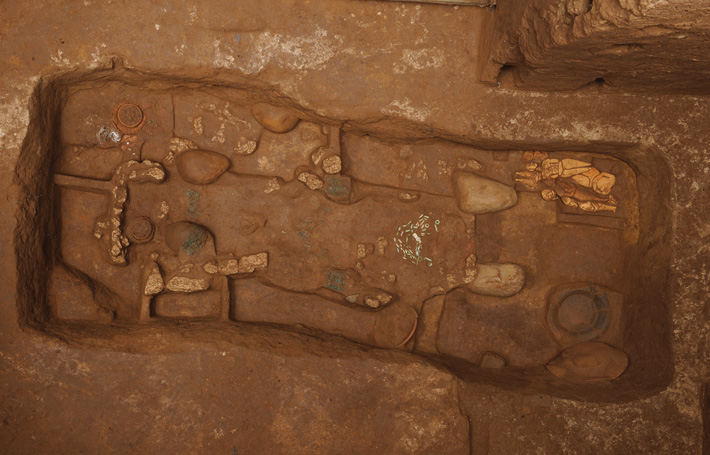After the discovery of the oldest royal tomb in Mesoamerica in a pyramid in the archaeological zone of Chiapa de Corzo, another multiple burial has just been discovered that is supposed to have occurred in 500 BC and which was accompanied by a rich offering between whose objects include a necklace with an Olmec style earring.

Also located in Mound 11 of the Archaeological Zone of Chiapa de Corzo, in Chiapas, in this second discovery were found the skeletal remains of two adult males, located inside one of the corners of the excavation area of said knoll. Due to its difficult location and the poor state of conservation of the bones, the burial was partially explored, in a portion of one meter per side and 50 centimeters deep from the mound.
Archaeologist Lynneth Lowe of the Center for Mayan Studies at UNAM said:
“We explored the east bank of the tomb, which was roofed with wooden spiers and planks that were defeated by the weight of the earth. This caused the bones to be very fragmented and only cranial bones and vertebrae of these characters were rescued, which were deposited around 500 BC, perhaps as companions of a higher ranking character. It is a very rich burial. Offerings that were symbolically related to the underworld were found in the explored part, composed of five vessels, shells, snails, animal remains, including fragments of a crocodile’s skull, a brocade attire with dozens of canine fangs and the shell of a turtle, a small necklace of jade beads and parts of two bone masks. Among the offerings that were covered by a dense black clay, two engraved earrings that were part of necklaces were discovered, one of which stands out because it presents the profile of a character with Olmec features. Made with the shell of a turtle, this pendant is unique because so far there is no other similar piece. Fragments of other sites in the region are known, but not complete.The other earring, made of an iron ore, was partially broken and has the representation of the silhouette of a deer. The general characteristics of the multiple burial and its offering confirm the early use of Mound 11 of Chiapa de Corzo as a funerary space for people of high rank; In addition to the connection that this settlement maintained with the Olmec nuclear area on the Gulf Coast, in particular with La Venta. Mound 11 was a pyramid that must have been between 6 and 7 meters high at that time, and represented the main construction of the site in its early periods, as the dignitaries were buried there. But in later times, around 100 AD burials of this type began to be carried out in smaller buildings. The sum of all the pieces found in the offerings seems to indicate that Chiapa de Corzo had relations with the area of the Gulf of Mexico, the Pacific Coast, the Motagua River Valley basin of Guatemala, and the Central Valleys of Oaxaca. Inhumations of this type began to take place in smaller buildings. The sum of all the pieces found in the offerings seems to indicate that Chiapa de Corzo had relations with the area of the Gulf of Mexico, the Pacific Coast, the Motagua River Valley basin of Guatemala, and the Central Valleys of Oaxaca. Inhumations of this type began to take place in smaller buildings. The sum of all the pieces found in the offerings seems to indicate that Chiapa de Corzo had relations with the area of the Gulf of Mexico, the Pacific Coast, the Motagua River Valley basin of Guatemala, and the Central Valleys of Oaxaca”.
